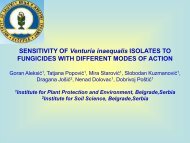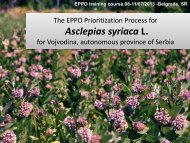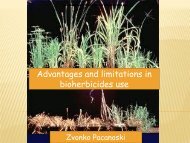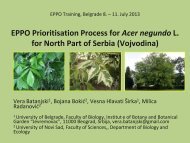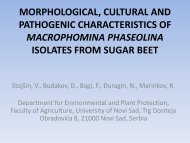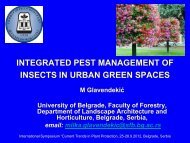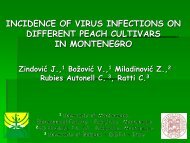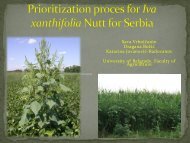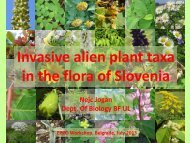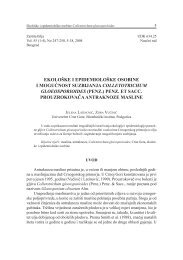ZAŠTITA BILJA PLANT PROTECTION
1 - Izbis
1 - Izbis
- No tags were found...
Create successful ePaper yourself
Turn your PDF publications into a flip-book with our unique Google optimized e-Paper software.
Growth promotion of alfalfa with rhizobacteria<br />
39<br />
2008) and represent the major challenges in the use<br />
of bio-inoculants. Characterization of the degree to<br />
which symbiotic microbes vary in the provision of<br />
mutualistic benefits in relation to environmental<br />
quality, host species and plant community structure<br />
is critical to developing an understanding of<br />
their role as agents of productivity and selection in<br />
natural populations (Martines-Viveros et al., 2010;<br />
Thrall, 2011).<br />
The mixture of strains applied in presented<br />
study promoted alfalfa SDW similar like middle<br />
effective strains E1 and P1 (by 27% over Ø). Except<br />
strain competition for place on rhizoplan and internal<br />
of the root tissue, the important role is played by<br />
plants in selecting and enriching the types of bacteria<br />
by the constituents of their root exudates. Therefore,<br />
the bacterial community in the rhizosphere<br />
develops depending on the nature and concentrations<br />
of organic constituents of exudates, and the<br />
corresponding ability of the bacteria to utilize these<br />
as sources of energy (Saharan and Nehra, 2011). It<br />
is not certain if plants actively select beneficial soil<br />
microbial communities in their rhizosphere. Composition<br />
of root exudates was shown to vary with<br />
plant species and stage of plant growth (Jaeger et al.<br />
1999).<br />
The presented study showed a significant<br />
positive influence of preceding barley inoculation<br />
with rhizobacteria alone and their mixture on shoot<br />
yield and total N contents of alfalfa. Results indicated<br />
that strains of Azotobacter sp., Pseudomonas<br />
sp. and Enterobacter sp. alone can be investigated<br />
in further researches as potential agent of biofertilizer<br />
for plant growth promotion of alfalfa.<br />
ACKNOWLEDGEMENT<br />
This study was supported by Ministry of Education, Science and Technological Development of the Republic<br />
of Serbia, Projects, No TR-37006 and III 46007.<br />
REFERENCES<br />
Abbas-Zadeh, P., Saleh-Rastin, N., Asadi-Rahmani, H., Khavazi, K., Soltani, A., Shoary-Nejati, A. R., Miransari,<br />
M. (2010): Plant growth-promoting activities of fluorescent pseudomonads, isolated from the Iranian soils.<br />
Acta Physiol. Plant., 32: 281–288.<br />
Adjanohoun, A., Allagbe M., Noumavo P. A., Gotoechan-Hodonou H., Sikirou R., Dossa K. K., GleleKakaï R.,<br />
Kotchoni S. O. , Baba- Moussa L. (2011): Effects of plant growth promoting rhizobacteria on field grown maize.<br />
Journal of Animal & Plant Sciences, Vol. 11 (3): 1457-1465.<br />
Antoun, H., and Prevost, D. (2000): PGPR activity of Rhizobium with nonleguminous plants. Available on<br />
http://www.ag.auburn.edu/ argentina/pdfmanuscripts/tableofcontents. pdf<br />
Avis T.J., Gravel V., Antoun H., Tweddell R.J.. (2008): Multifaceted beneficial effects of rhizosphere microorganisms<br />
on plant health and productivity. Soil Biol. Biochem., 40: 1733–1740.<br />
Bergey’s Manual of Systematic Bacteriology (1984-1989): J.G.Holt, Editor-in-Chief, Williams and Wilkins, Baltimore,<br />
MD, USA, 1-4.<br />
Bhattacharjee, R.B., Singh, A., Mukhopadhyay, S.N. (2008): Use of nitrogen-fixing bacteria as biofertilizer for<br />
non-legumes: propects and challenges. Appl. Microbiol. Biot., 80: 199-209.<br />
Bhattacharyya, P.N., Jha, D. K. (2012): Plant growth-promoting rhizobacteria (PGPR) emergence in agriculture.<br />
World J. Microbiol. Biotechnol., 28: 1327–1350.<br />
Delić, D., Stajković Srbinović, O., Kuzmanović, Đ., Rasulić, N., Maksimović, S., Radović, J., Simić, A. (2012):<br />
Influence of Plant Growth Promoting Rhizobacteria on Alfalfa Medicago sativa L. yield by Inoculation of a Preceding<br />
Italian Ryegrass, Lolium meltiflorum Lam. Breeding Strategies for Sustainable Forage and Turf Grass



